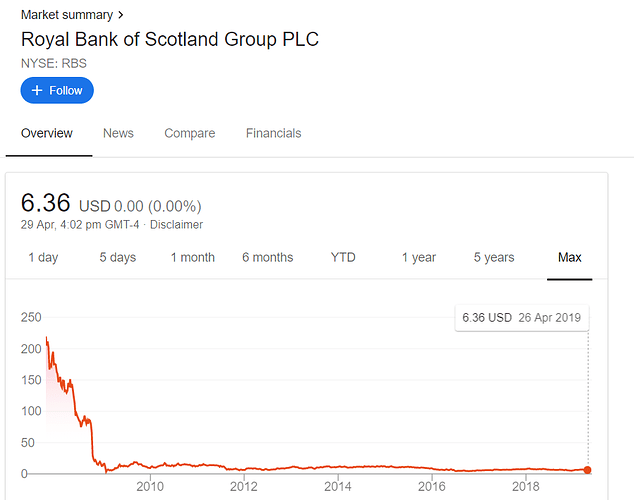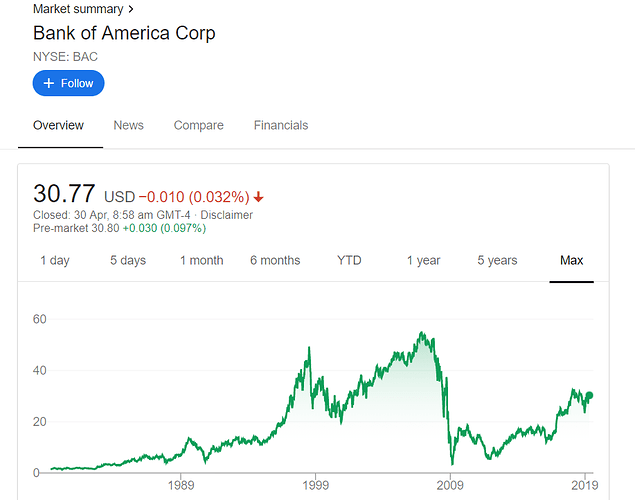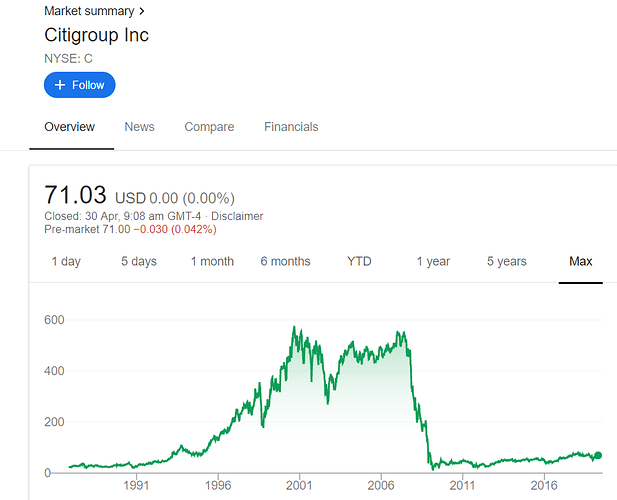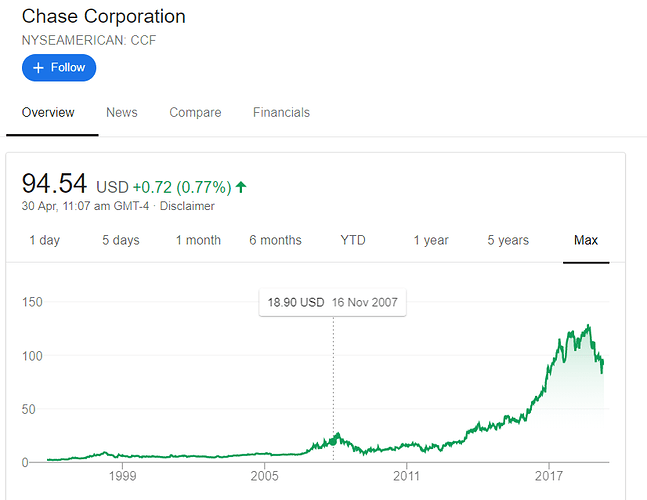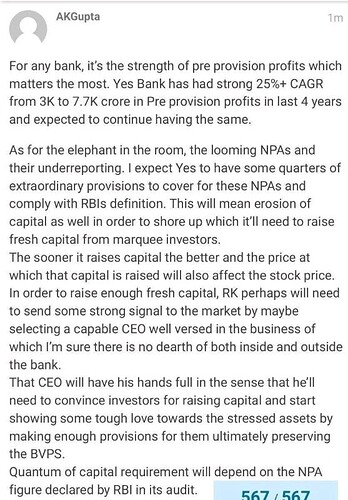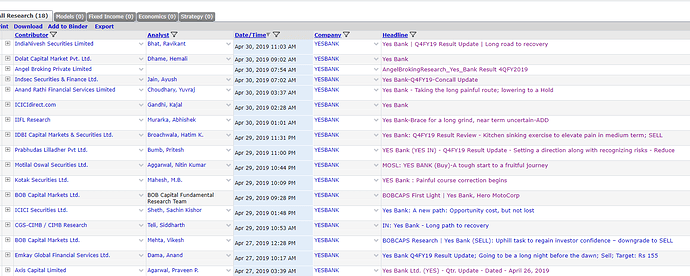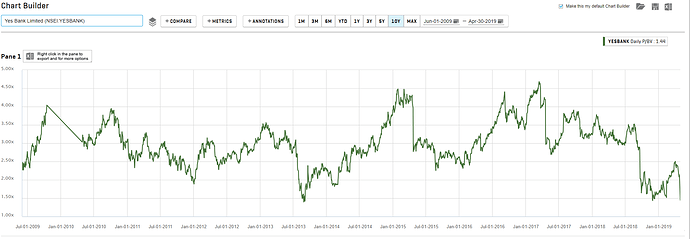UBS has been highlighting the rot in Yes Bank since long
FIIs have trimmed their holdings considerably in ICICI Bank since Dec '15 (last 3 years) - from 53.48% to 43.02%. There was only a marginal increase in holding as of Mar '19 quarter. It doesn’t look like ICICI bank is a beneficiary of FII buying.
Axis Bank OTOH, FIIs have increased stake from 42.13% in Dec’15 to 49.62% as of Mar '19. So Axis is definitely a big beneficiary of increase in FII holdings. Notably MFs as well have increased stake from 10.76% to 15.35% in the same period. The govt. has reduced about 10% stake meanwhile via SUUTI, LIC and other state insurance companies.
Yes Bank is an interesting case where FII holding was 41.38% as of Dec '15 and rose up to 46% in FY’18 but it had come down considerably to 36% as of Dec '18 but after Rana Kapoor removal and recent run-up FIIs thought all was well and increased stake back up to 40.33 - making this a FII heavy stock as of today, because their holding is almost unaltered since Dec '15. This is where technically it is ill-equipped to handle current sell-off, because the weighty Morgan Stanley, Macquarie and UBS analyst reports are stacked against them.
If you look at DHFL, FII selling of about 8% (from peak) killed the stock to about a quarter of its peak valuation. In Yes bank’s case, FIIs are loaded up and have even got their recent call wrong on the long side, so trimming their holdings by even 5-10% is going to be pretty stiff pressure on the stock I think. I doubt if anyone is going to give it a helping hand other than retail which is already up from 6% to 11% levels. Won’t be surprised to see brave retail’s holding go up to 18-20% in June '19 SHP.
Disc: No holdings. This is purely of academic interest to me, to observe behaviour of participants.
Raising capital seems to be the first and foremost trigger for me for the markets (equity) to start giving Yes Bank stock some stability. Somehow, a hunch tells me that by September-October 2019 Yes Bank should be on a relatively much better footing than now. No data to back this up, so take it with a bagful of salt. Good luck all. 
Thanks for always coming with data to substantiate your hypothesis @phreakv6. Really appreciate, I will not make any comment on Yes Bank for personal reasons. However, to the point of tagging retail, fii, mutual fund buying and its association with stock price movement, whatever comments are being made taking 4-5 companies as example, is a totally useless exercise. If one is really interested to do this methodologically in an conclusive manner, Please take 5-10 years of history, identify all stocks where such phenomenon happened taking multiple scenarios +5/10/15/20% shift, identify sustainable price movements and check if there is a positive or negative correlation. Else any justification on the basis of 2-4 stocks could be randomness instead of pattern. There has to be a strong correlation and difference of pattern between cohorts on a consistent basis across years to prove any points else it is total futile
Pointers: To add, life is more complex than simple, if anyone is doing such experiments, not only take simple hypothesis scenarios, like A segment holding went down but also complicated one like when A goes down n B goes up, what was % rise or fall in this cohort vs rest.
My 2 cents, Yes is 5th largest bank and in deep mess due to multiple issues including management, aggressive lending practices to corporate, not having right asset mix, less focus on retail. I see the new CEO following RBI guidelines, being more proactive in NPA Classification, talking about predictable revenue streams, this is something that comes from Deutsche bank thinking if I am not wrong.
How often does banks go down or get closed? at least I have not seen this happen so easily as RBI would step in and try to do damage control. I assume banks won’t take the airline route. Worst case, the stock might take 2 digit route and finally become an acquisition candidate. I see 173M stocks as volumes potentially(around 7 to 8% ) could be on sale which means majority are selling after the Q4 results. Assuming FII, MF’s are heavy sellers then the absorption should be potentially by retail investors which will definitely push the price down…160,150,140…until some one big finds value and starts picking up volumes and then stocks start moving, like it happened last time.
For now, we don’t know how many more accounts will be classified as NPA’s( 1000 CRS to 25000 CRS->just a number, not sure…). Only next couple of quarters will give this visibility and also how fast Yes can scale in retail space which is highly competitive among top 3 players. If any one has visibility on NPA, please share some insights then this could be one basis to evaluate how bad it will be in future before the uptrend starts.
Disclaimer: Invested and sold 50% at recent high’s and waiting for right entry point again.
Gill gave an interview to CNBC this morning. It might answer few of your questions: https://www.cnbctv18.com/finance/yes-bank-ceo-ravneet-gill-denies-management-reshuffle-plan-eyes-growth-in-retail-sme-sectors-3130801.htm
This is not specific to yes bank but valid to all BFSI businesses
The world’s financial history is very unkind. India has a very small history and lot of that belongs to post liberalization where everything was flying. As you mentioned Deutche Bank (from where CEO has come), let me put price chart of last 18 years (in long run, price is reflection of performance).
Let me put few more big banks of the world. These banks are or were some of biggest banks across world but could not recover from one big crisis. No wonder financial is one space where there is total opposite opinion among top investors. Have read very less about world banking but it looks scary unlike India where for everything, there looks scope to grow. The economy grows with banking but not all banks are successful. There has been huge wealth erosion in many cases and identifying which one would not destroy wealth in long run need lot of effort as lot of dirt could be kept hidden for years and years
I am not sure such foreign examples are suited for India, even Buffett’s views are said to be not applicable to Indian context sometimes. So my question is which listed bank has gone bankrupt or have been in losses for years for whatever reasons? I could think of one Charminar bank in the early 2000s, which I think was unlisted.
Charts of other Indian banks like ICICI, Axis, SBI tell a different story. How do we reconcile this information with the charts of the foreign banks that you have shown?
The only unique thing here is that growth is keeping companies afloat despite extreme risk taking. Over long periods when growth tapers or is non-existent, blowups are quick and instantaneous. Since our banking is very fragmented (that’s how it should be, IMHO but it’s a topic for another day perhaps), we can always find solace in merging the small with the large and hope the piss in the pond/ocean is inseparable and unidentifiable, or we can merge equals and hope 0+0+0=3 (you know which one this is).
If obfuscation of bad assets doesn’t work, you can always raise more equity to wipe out your old blow-up, like a gambler/trader who blew up his margin account through excess leverage and is given more equity to play with because banking licenses aren’t easy to get and the narrative is that India has a rich potential demographic dividend and banking is bound to benefit and so on.
These (more equity + mergers) are what is keeping banks afloat. Maybe the govt./politician gets a cut thru preferential treatment for saving a financial entity. How long can these go on, even if these are unique to India? Is this what you want to put your savings on? Can banking regulations alone be a moat for their existence, and for how long?
Thanks for digging into the history. Yes for sure, Price reflects the performance. I quoted Yes current CEO’s previous company only to relate to predictable revenue streams and sustainability of the same while comparison to the previous leaders of Yes, who were into aggressive lending in SME space, may be also playing with technical loop holes to refinance the NPA’s so that provisions can be avoided even though the repayment capacity of the borrower is in question. I assume those days are gone now which is a +ve sign.
While there is definitely risk with YES and it is not in the category of top grade investment pick in banking space. Even looking at future, every bank just can’t run behind retail book, there will be businesses which require secured/unsecured lending at a cost which is usually high risk/high return where Yes is playing for some time now and will continue to do this as long as they can raise capital.
@Chirag, Thanks for the video link: I did listen to Mr Gill’s interview with Latha(seems latha and her team are super -ve about the bank from the body language and kind of stress on the questions to find answers), looks like they have another 20,000 crore(as per interview to ET now: https://youtu.be/KwUaCBVJy40 ) of loans on the watch list which could turn into NPA. So there could be more pain coming for this 20K CR, best case less than single digit % slippage, worst case more.
Few nos to share:
2.4L CR of loan book( last 6 QTRS, the loan book has grown very agressively)->This might cause more pain in future. if slippages in this core book can be taken care then there are +ve’s to come. I believe NCLT’s should guard the provisions and recovery should happen at certain % percentage of cost basis if not in full inclusive of the interest, may be experts can comment on this one.
->I believe 2.4L CR loan book is inclusive of retail book…
0.5M credit cards under Yes’s Kitty out of around ~46M credit cards across the country(0.1% of market share in CC), this is not much and potential for growth…
** Reserve Bank of India - Bankwise ATM/POS/Card Statistics
Plans to reduce savings bank interest rates to ~5 to 6% from 7+% now ->This might not be -ve for CASA pull back from customers as there are only few banks who are providing such high rates for savings a/c.
Retail book of around 70K Crore…
Clear of being the corporate bank in future and not a contender for being the top retail focused bank like HDFC…
All these examples are Investment Banks and completely different from a conventional Bank in the business of lending, cards and fees income. These Investment banks took extremely risky speculative derivatives exposures sometime with 100x leverage during the 2008-09 blow up. A better comparison with Indian Banks will be a conventional Bank like JPM, Chase and Wells Fargo.
Very valid point. Infact fees is pretty much like pure service and does not have any credit risk/cost.
I enjoy every time the discussion happens on this thread. I see many people who profess about being value investors or worshippers of famous value investors suddenly change tune when it comes to a stock which is beaten black & blue due to business problems. Now I don’t know if Yes Bank qualifies as a value investment today but I’ve seen Axis & ICICI face the same kind of problems and emerge from them strongly. ICICI went down to 260 before now touching 400+ and Axis went to 480 before moving to 750+ now.
Both had bad loans divergence issue, leadership turnover, quarterly losses, capital raising and eventual new direction set by new CEO (in this order no less!) which the market cheered as reflected in the price movements.
I don’t know why people are perceiving some other direction for Yes when all the signs are pointing to the same trajectory as Axis and ICICI - leadership turnover, quarterly losses due to high provision, capital raising plans and new direction by CEO ( slower, more responsible growth in book, more focus on compliance, book clean up, retail SME focus etc.).
Just sharing what I had written back in the dark days of Q3’19:
Disclosure: invested
That’s a chemical company, not Chase the financial company. Chase was actually taken over by JP Morgan, and its long term chart is nowhere near as stunning (although it is still great, and near the top along with Wells Fargo in the US).
That being said, I don’t think it is an appropriate comparison to make, simply because banking system NIMs in India are structurally much higher due to the lower penetration, which causes higher RoE’s and shareholder returns.
As for Yes Bank, my 2 cents:
-
Recoveries for cases in bankruptcy (outside Real Estate with a direct pledge on underlying land, due to Sarfezi) have historically been quite low, as banks were unable to recover money from stressed companies by auctioning them off as in NCLT. This is one of the reasons the PSU banks/Axis/ICICI suffered when their corporate loan book soured. All of this has changed with IBC, and banks are seeing much higher recoveries, like in the cases of Essar Steel/Monnet than before. Cases that fall into bankruptcy now will face a much shorter time period to resolution, boosting recoveries.
-
If you look at how Yes Bank has lent to risky groups in the past, it has always been against direct pledge of easily invokable securities/land, as opposed to lending on a corporate level or for project lending. Lets take a look at some of the accounts Yes Bank has mentioned as being chunky exposures:
-
IL&FS → 2600 cr or ~ 33% of Yes Banks’ gross NPL’s
If you look at IL&FS Transportation’s Income Statements, you’ll see that it generates ~4200cr of EBITDA compared to ~34,000 cr of debt. Any debt owed to ITNL will probably not require a large haircut given the strong underlying cashflows of the projects as well as the 9 months of interest payment-mortaium that has already passed, allowing the company to generate close to ~1500cr of cash (conservatively) over this period. As for HoldCo debt, much of it is owed to the various subsidiaries of IL&FS/ITNL as well as other projects (such as solar/wind), which should be able to be auctioned. Given the interest shown by foreign funds in Indian infrastructure assets, I am certain that they will receive close to fair value for these assets
I estimate a maximum ~30% haircut on loans to ITNL and ~40% to IL&FS at the holdco level, which shouldn’t cause much further pain given its more likely that haircuts are in the range of ~20%/30%, which is not too far off from the existing provisions of 25%.
It is in the government’s interest to solve the mess at IL&FS as quickly as possible, and with Uday Kotak at the helm, I expect a resolution within the next 6-9 months, which would be extremely bullish for Yes Bank.
As for some of the BB- rated real estate exposure that was provisioned, it is unlikely that Yes Bank would have to face haircuts larger than ~30% even in a distress sale - there would be a line of buyers out the door for finished residental real estate at a discount. Keep in mind, these accounts are still standard, and it is possible that they end up paying most of the principal, maybe with some extentions if the sales are too slow.
As for what is already in the price of Yes Bank, I pulled up research reports from ~15 brokers, and only 2 of them still had a buy or add rating on the stock.
“Taking the painful route”, “Brace for a long grind”, “elevated pain in medium term”, “a tough start to a fruitful journey” etc. If this isn’t consensus, I don’t know what is. And if everyone has already sold the stock/wants to sell a stock, then its probably a pretty good time to buy. Here’s the valuation over the last 10 years:
By the way, a philosophical question.
If you were a new CEO of a business, where much of your compensation came in the form of stock options/long term ESOPs, would you rather have a lower stock price in the beginning (i.e. option strike price), or a higher one? Think and anwser… ![]()
Never forget the power of incentives…
Which tool gave you all latest research reports in one place?
My opinion is that the stock is falling on the concern of divergence. If the issue was big enough for RBI to remove RK, there is clearly something going on. You can’t lend to everyone on the street and then claim 1% NPAs. I feel we’ll see the real pain when the new management comes in and starts the clean up. There is no smoke without fire.
Both net and gross NPAs(in %age terms) are 220-250% of original amount since this post.
I spoke to an employee of the bank. They are continuing to lend normally to retail now. After RK had to leave, they had temporarily slowed the expansion of some of their retail lending plans.
While I was Yes Bank Shareholder in 2016, So thought of opening bank account. There sales personnel promised as usual Gaga about return of 7% for savings account for ever and best in class technology. After my experience I found both the savings rate promise was false t came with caveat and their online portal was mediocre. I exited because of my own experience and believed in IMHO over hyped bank but post my exit it had rallied more than 2X. I don’t think it will sustain its position in Nifty50.
Disc- No position


